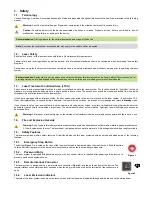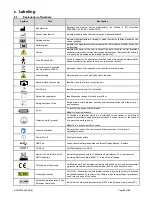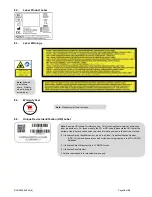
RSR-000885-000 (6)
Page
12
of
20
4.4.1. Pigment Considerations
This laser system will deliver a dual wavelength of 810 nm and 980 nm light which has been found to provide therapeutic relief of pain. This
laser system allows the operator to choose skin color type for the patient. Since darker pigments will absorb 810 nm wavelength more than
lighter pigments, the software will adjust the output so that it contains 100% 980 nm wavelength when the dark skin setting (Fitzpatrick V or
VI) is selected.
Other circumstances when it may be appropriate to use this setting include:
•
Highly pigmented areas, such as areas with a dark sun tan, or areas with a tattoo
•
Areas with dense hair growth, such as the nape of the neck
4.4.2. Dose
The laser energy dose delivered during a treatment is measured in joules. This number is displayed on the screen during a treatment and is
calculated by multiplying the average power (in Watts) by treatment time (in seconds). Laser treatment should be applied to an area using a
scanning application.
The software protocols in the laser system are designed to deliver a dose appropriate for the treatment area and conditions input by the
operator. It is recommended that treatment information (pre-set protocol and input settings or power, energy delivered, treatment time, and
treatment area) is recorded for each treatment.
•
In general, doses are delivered to the area of pain, the surrounding tissues, and along the nerve pathway for the specific area
experiencing the pain.
•
Treat muscles connecting to a painful joint in addition to tendon attachments.
4.4.3. Setting Treatment Expectations
Patients and clinicians need to understand the possibilities and limitations of the application of deep tissue laser therapy. Chronic pain may
require several treatments before a beneficial effect is achieved. Deeper tissues may require multiple treatments before significant benefits
are derived.
A typical treatment regimen may consist of three treatments spaced one day apart during the first week, two treatments the following week,
and one treatment in week three. If no benefit is derived after the 6 to 10 treatments, then the patient’s options need to be reviewed considering
the condition and response. Occasionally, a patient can experience a tingling sensation or soreness due to increased blood flow. In these
instances, it is recommended to wait until the soreness subsides before continuing with additional treatments.
4.4.4. Treatment Technique
Warning:
•
DO NOT
allow any reflective objects to fall into or obstruct the path of the laser energy produced by this device. The operator,
all assistants, and the patient must remove all reflective objects (such as rings, metal watchbands, and jewelry) prior to
treatment with this device. Direct or indirect eye contact with scattered laser light from any reflective surface can cause serious,
irreparable corneal and/or retinal damage, and possible blindness to one or both eyes.
•
DO NOT
pretreat tissue (e.g. with a heating pad or wet compress) before laser treatment. Tissue to be treated must be dry
and at normal temperature before laser treatment begins.
•
Use carefully. May cause serious burns. Do not use over sensitive skin area or in the presence of poor circulation.
•
During treatment, it is important to get feedback from the patient concerning their comfort level. The laser provides a soothing
warmth. Be cautious in cases where the patient has limited sensation or is not able to respond to increases in temperature and
consider treating at a lower power setting. If the patient expresses any discomfort, the power output should be reduced.
•
Treatment should be delivered to exposed skin. Do not treat through clothing or bandages. The
treatment area should be clean and free of surface dirt or oils.
•
Isopropyl alcohol solution (70% alcohol) may be used to clean all instrument surfaces that are in
contact with the patient (See Section 5.1 for cleaning instructions). Be sure to allow the solution
to evaporate before initiating laser emission.
•
For optimal delivery of the dose, keep the treatment head perpendicular to the skin surface.
Continuously move the treatment head at a rate of approximately 3-10 cm/sec (1-3 in/sec).
•
To ensure an even distribution of the dose to the treatment area, continuously move the treatment
head over the area first moving continuously back-and-forth horizontally, and then moving back-
and-forth vertically in a grid pattern (see
Figure 24
). Make sure to cover the entire area to be
treated with this “painting motion”.
•
Treatments can be applied in conjunction with stretching or gentle range of motion exercises.
5. Maintenance
Warning:
DO NOT
attempt to gain access to any internal component. Doing so may cause serious and/or irreversible injury.
THERE
ARE NO USER-SERVICEABLE COMPONENTS
inside this laser device.
5.1. Cleaning
Warning:
•
It is recommended to always turn off the laser system and unplug the power cord from the wall outlet before cleaning the
system.
•
Always use protective eyewear and gloves when cleaning and disinfecting any equipment.
•
Clean the contact treatment heads (Rolling Pin, Large massage ball and Small massage ball) between treatments to prevent
cross-contamination and infections.
•
DO NOT
use a treatment head immediately after cleaning with alcohol solution. Wait until the solution used in the cleaning
procedure completely evaporates. Not allowing it to dry may cause the laser to ignite alcohol solutions or vapors.
Figure 24
Содержание LIGHTFORCE XLi
Страница 251: ...RSR 000885 000 6 Pagina 7 di 22 ...
















































